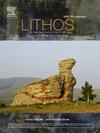Origin of Eocene adakitic porphyries in the Binchuan–Weishan area, southeastern Tibetan Plateau: Constraints on the initial left-lateral strike slip of the Diancangshan–Ailaoshan tectonic zone
IF 2.9
2区 地球科学
Q2 GEOCHEMISTRY & GEOPHYSICS
引用次数: 0
Abstract
The India–Eurasia collision during Cenozoic era has led to large-scale uplift and lithospheric extrusion of the central Tibetan Plateau. As a vital boundary for accommodating the compressive stress in the interior of the plateau, the Diancangshan–Ailaoshan tectonic zone (DATZ) in Yunnan Province has witnessed to this evolutionary history and documented the tectonic processes. As the indication of the collisional process at depth, the Cenozoic potassic magmatic rocks that developed along the DATZ are the critical lithological probe for elucidating the deep dynamic mechanisms underlying the India–Eurasia collision and their connection with the plateau's lithospheric extrusion. In this paper, we present new zircon U-Pb, Hf and O isotopic data, along with whole-rock major and trace elemental compositions, and whole-rock Sr-Nd isotopic data of Eocene porphyries located at the junction of the Diancangshan and Ailaoshan metamorphic massifs in Yunnan Province. Zircon U-Pb dating results indicate that they were emplaced at 37–35 Ma. Geochemically, all the studied porphyries exhibit an affinity to potassic adakitic rocks with the enrichment in K2O (K2O = 3.88–5.69 wt%), high Sr contents (mostly >400 ppm), elevated Sr/Y ratios (30–106), and low Y and Yb contents, indicating an origin from the partial melting of the thickened mafic continental lower crust which is garnet-bearing amphibolite. However, the disparity in zircon Hf and O isotopic compositions between the Binchuan–Midu and Weishan granitic porphyries reflects their different sources. They are the Neoproterozoic and Late Paleozoic mafic lower crust that formed during the Neoproterozoic and Paleo-Tethyan subduction, respectively. By integrating regional data, including structural feature, metamorphism, sedimentation and magmatism patterns, we propose that the generation of the late Eocene (37–35 Ma) potassic rocks along the Jinshajiang–Ailaoshan tectonic zone in Yunnan Province was a consequence of the southeastward extrusion of the central Tibetan Plateau lithosphere, coupled with the left-lateral shearing of the DATZ and the rotating of the Lanping–Simao and Yangtze blocks.
求助全文
约1分钟内获得全文
求助全文
来源期刊

Lithos
地学-地球化学与地球物理
CiteScore
6.80
自引率
11.40%
发文量
286
审稿时长
3.5 months
期刊介绍:
Lithos publishes original research papers on the petrology, geochemistry and petrogenesis of igneous and metamorphic rocks. Papers on mineralogy/mineral physics related to petrology and petrogenetic problems are also welcomed.
 求助内容:
求助内容: 应助结果提醒方式:
应助结果提醒方式:


